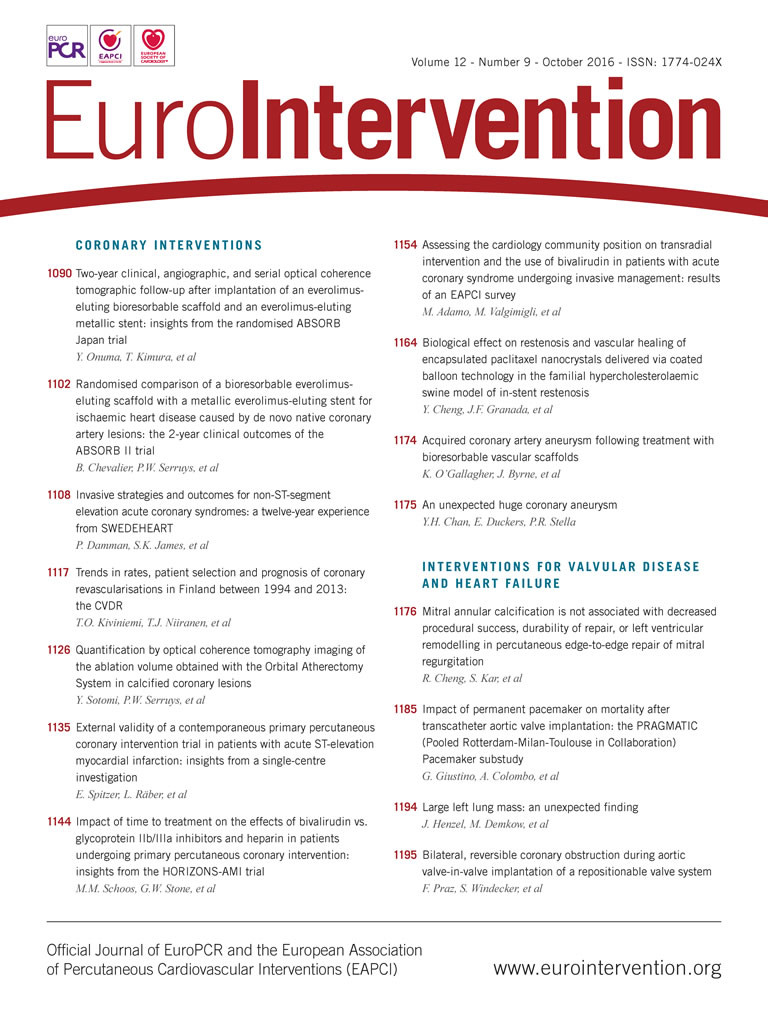
Atherectomy ablative devices have been designed for the treatment of calcified and fibrotic coronary lesions. Rotational Atherectomy (RA) was introduced for clinical use over 20 years ago, while the orbital atherectomy systems (OAS) were approved for clinical use in the USA in 20131. Nevertheless, the use of these devices is less than 5%, limited to selected operators, and used in some of the heavy calcified lesions. Further, the qualitative and quantitative impact of the atherectomy ablative effect on the lesion has not been well characterised. The use of high-resolution imaging with optical coherence tomography (OCT) has been able to elucidate the mechanistic effects of such ablative devices, quantify the volume of ablation, especially with regards to the specificity of the atherectomy device to chip hard/calcified plaques versus a broader effect across the spectrum of plaque types. The latter is exemplified in the report by Sotomi et al that studied 18 patients with complex calcified coronary lesions who received treatment with OAS2. The main findings of the study were that the OAS ablative effect was not only limited to the calcified sectors of the plaque, but also extended to non-calcified tissue. Although dissections were observed in half of the ablated lesions, they were confined mainly to the intima, some to the media, and none to the adventitia. This study proved the effectiveness of the device in debulking coronary lesions, and proposes a new methodology to evaluate the volume of the ablation using OCT. It is doubtful that this methodology can be used as a surrogate to support safety and efficacy and, even if validated, will be accepted by the regulatory bodies in the USA and Europe. Still, it holds the potential to better quantify the ablative effect of the atherectomy systems.
Nevertheless, there are some safety concerns that were not fully addressed in this manuscript: OAS erodes coronary plaques in such a way that small parts of the plaque are embolised downstream. In this study, a median 1.76 mm3 of coronary tissue was ablated and ended up in the distal bed, whether there is more myonecrosis or microvasculature dysfunction following the use of OAS remain to be investigated2. Although OAS facilitates stenting, the cavities created by OAS may create small areas of malapposition, since coronary devices may not conform to the capricious morphology of the newly created cavity. As a matter of fact, the mean of the largest malapposition area reported is close to the median debulked tissue volume, but we do not know if the ablated areas correspond to the same malapposition locations. Finally, there is a lack of solid data derived from randomised clinical trials for the use of ablative devices versus balloons in calcified lesions to support routine use of either RA or OAS systems.
The Food and Drug Administration (FDA) granted approval for the Diamondback 360® coronary OAS (Cardiovascular Systems, Inc., St. Paul, MN, USA) on October 20131. The device is indicated to facilitate stent delivery in patients with coronary artery disease who are acceptable candidates for percutaneous transluminal coronary angioplasty or stenting due to de novo, severely calcified coronary artery lesions. The approval in the USA was granted based on a robust bench testing, preclinical and clinical evaluation of the OAS system preformed in accordance with applicable guidance documents and national and international standards. The testing confirmed that the OAS met performance and design specifications. The performance goals for both the primary endpoints were met, demonstrating the safety and effectiveness of the Diamondback 360 Coronary OAS in treating severely calcified coronary lesions, lesions that are difficult to treat and typically excluded from clinical studies. The primary results were confirmed by additional supportive and sensitivity analyses and results were clinically acceptable in the patient population studied. Therefore, the data in the Pre-Market Approval (PMA) application provide reasonable assurance of the safety and effectiveness of this device when used in accordance with the indications for use. Surprisingly, the OAS does not have a Conformité Européenne (CE) mark, therefore it is not approved for clinical use in Europe. Although we do not have insight into the status of the application, it appears that the sponsor would be required to provide clinical data derived from European patients performed by Europeans operators for such approval. This discrepancy in the approval sequence between the USA and Europe is in stark contrast to the historical patterns of high-risk device approvals, which is usually faster in Europe when compared to the USA.
Overall, the medical device approval process is drastically different between the USA and Europe. Although both regulatory agencies primarily ensure safety, the FDA also evaluates effectiveness and requires a powered randomised clinical trial to support efficacy. In the United States, the FDA often requires manufacturers of high-risk devices, such as the OAS, to demonstrate safety and effectiveness before the devices can be marketed. This premarketing process is associated with higher expenses and slows the approval process, which has been subject to criticism for delaying the accessibility of novel devices for American patients. Conversely, European Conformity (CE from “Conformité Européenne”) marking is faster since manufacturers or importers only need to show compliance with the relevant European Union legislation. Indeed, the European Union (EU) website describes the following, that CE “… appears on many products traded in the European Economic Area (EEA)”, which means that they have been assessed to meet high safety, health and environmental protection requirements3. The EU directives outline requirements under which a medical device (as well as other commercial goods) could be marketed across all EU member states after earning a CE mark in any of the member countries. The CE marking process is conducted by a for-profit, third-party, “notified bodies” that have been accredited by a member country to assess device safety and performance, but do not evaluate effectiveness4,5. Recently, there has been growing criticism of European regulatory policy for being too cavalier and potentially subjecting Europeans to being treated with devices that have not proved efficacy. As a result, we are experiencing an interesting dynamic within the approval process, with an inconsistency of requirements among the different notifying bodies with some becoming more rigid with respect to approval; while the FDA has become more transparent and predictable in accordance with guideline documents and more expeditious in timing for approval in the USA. The FDA is also willing to approve devices for marketing in the USA based on studies that evaluate safety and effectiveness from credible centres outside the USA. For example, we can look at the most recent approval of the radiofrequency shock wave lithoplasty (another ablative technology) which was approved for clinical use in the treatment of calcified lesions in the SFA6.
The ultimate questions are: why are there such differences in the regulatory process, and why is there an apparent need to generate duplicate data? After all, calcified lesions have become calcified irrespective of the ethnicity or the nationality of the patient. It is time to harmonise the regulatory proceedings across the globe. Regulators should accept joined studies for specific devices internationally that will collect repository data which can be used by each agency based on their own criteria. Such efforts were successfully implemented between the Japanese and the USA regulatory bodies.
While the time necessary for device approval for marketing is important, reimbursement is a key to secure availability of these devices for our patients. Most European patients do not have access to innovative, high-risk devices as soon as these devices receive CE marking due to the lack of simultaneous reimbursement approval. The process of reimbursement varies from country to country in Europe. Some countries require cost-effectiveness studies to support reimbursement, some countries give high reimbursement for a limited period of time, recognising the new innovations. Often the cost-effectiveness data comes from the USA pivotal trials. In contrast, in the USA, data to support effectiveness are embedded in the pivotal trial design and therefore often facilitate simultaneous CMS reimbursement with the FDA. It is because of these differences between the USA and Europe that the totality of time from the sponsor application to patient device access may not be significantly different between the EU and USA. The lack of uniformity in regulation and reimbursement should no longer be acceptable. Patients across the globe should be entitled to be treated by the same data parameters of safety and efficacy. This will require more collaboration and harmonisation across agencies to secure a transparent, reasonable and expeditious process.
With the ever-increasing complexity of PCI, it would be desirable to have available atherectomy devices at hand, such as OAS, to enable better deliverability of the stent and improved procedural success and outcome. In the case of OAS, the European regulators should accept the FDA approval for the treatment of European patients with calcified lesions and grant CE marking for this device.
Conflict of interest statement
R. Waksman is a consultant for Abbott Vascular, Biotronik, Boston Scientific, Medtronic, St. Jude Medical; on the speakers bureau for AstraZeneca, Boston Scientific, Merck; and receives grant support from: AstraZeneca, Biotronik, and Boston Scientific. H.M. Garcia-Garcia has no conflicts of interest to declare.

